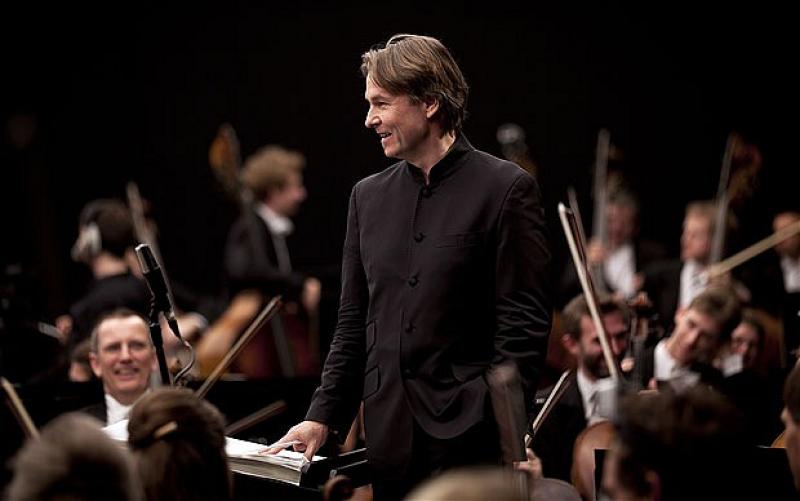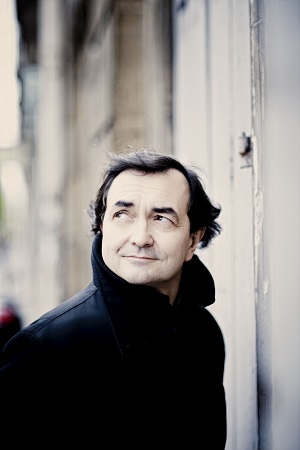Aimard, Philharmonia, Salonen, RFH | reviews, news & interviews
Aimard, Philharmonia, Salonen, RFH
Aimard, Philharmonia, Salonen, RFH
Unearthed Stravinsky is a revelation, while Ligeti and Ravel dazzle

A new work by Igor Stravinsky is always going to be a major event, so Sunday evening’s UK premiere of his rediscovered Funeral Song was hotly anticipated.
Funeral Song is an early work, dating from 1908, but it’s not juvenilia. Written as a memorial to Stravinsky’s teacher, Rimsky-Korsakov, the music seems to consciously imitate his style, especially his rich orchestral colours and bold but constantly shifting harmonies. There is little of Stravinsky’s later rhythmic sophistication, but the orchestration is as masterful as that of his Diaghilev ballets. In later life, Stravinsky recalled “the idea ... was that all the solo instruments of the orchestra filed past the tomb of the master in succession”. And so it proves, with a graceful three-bar theme, first introduced in the solo horn and then passed around the soloists and instrumental sections.
Given Stravinsky’s later penchant for revision, he may have revisited the work's ending had he the chance – a huge cut off at the climax seems needlessly jarring, and the coda lacks coherence, with unrelated harmonies juxtaposed from different sections of the orchestra. But this performance was excellent, especially given the lack of performing tradition for the work. Esa-Pekka Salonen took a patient but focussed approach, stringing the successive statements of the melody into long, unbroken lines and carefully building to the work’s climax.
 The lightness and whimsy of Ligeti’s Piano Concerto provided ideal contrast to the sombre opener. Pianist Pierre-Laurent Aimard (pictured left by Marco Borggreve) is closely associated with the work, as is Salonen with all of Ligeti’s orchestral music, so expectations ran high, and were not disappointed. Salonen opted for the chamber version of the work, with just five strings, a wise choice, as the balance here was ideal, weighed more towards the winds and percussion, and allowing more space for the introverted and busy piano part. The precision of the Philharmonia’s playing was never in doubt, but Salonen avoided making the textures too fussy or clean – something the composer himself also ensures by often doubling the woodwind lines with ocarina and swanee whistle. The two percussionists were unfortunately positioned behind the piano and obscured by the raised lid, making the vast array of bizarre sounds they produced all the more intriguing and mysterious. Best of all was Aimard, whose darting, mischievous movements around the keyboard are ideal for Ligeti’s playful and complex lines. Again, there was a sense here that, for all his consummate mastery, Aimard was careful to maintain the messy and anarchic character of the work – his perfection was unquestionable, but somehow he made it seem accidental too.
The lightness and whimsy of Ligeti’s Piano Concerto provided ideal contrast to the sombre opener. Pianist Pierre-Laurent Aimard (pictured left by Marco Borggreve) is closely associated with the work, as is Salonen with all of Ligeti’s orchestral music, so expectations ran high, and were not disappointed. Salonen opted for the chamber version of the work, with just five strings, a wise choice, as the balance here was ideal, weighed more towards the winds and percussion, and allowing more space for the introverted and busy piano part. The precision of the Philharmonia’s playing was never in doubt, but Salonen avoided making the textures too fussy or clean – something the composer himself also ensures by often doubling the woodwind lines with ocarina and swanee whistle. The two percussionists were unfortunately positioned behind the piano and obscured by the raised lid, making the vast array of bizarre sounds they produced all the more intriguing and mysterious. Best of all was Aimard, whose darting, mischievous movements around the keyboard are ideal for Ligeti’s playful and complex lines. Again, there was a sense here that, for all his consummate mastery, Aimard was careful to maintain the messy and anarchic character of the work – his perfection was unquestionable, but somehow he made it seem accidental too.
For the second half, Ravel’s Daphnis and Chloe. Performing the full ballet rather than the usual concert suites emphasised Ravel’s innate sense for musical storytelling, and his masterly orchestration meant that nothing here ever felt redundant. Salonen’s ability to think in long spans, even through numerous time changes in quick succession, impressively maintained the focus. Projecting the section titles from the ballet above the orchestra seemed a distraction to begin with, but it served to demonstrate the composer’s attention to detail in reflecting every element of the onstage action in the score.
The Philharmonia always plays well for Salonen, but they were on particularly fine form for this evening’s varied and demanding programme. The orchestra was particularly impressive in the Ravel. The score belongs to the flute section, who all excelled, particularly principal Samuel Coles and alto Karen Jones. Excellent cor anglais solos too, from Jill Crowther. And a lush, radiant string tone, particularly glowing in the "Daybreak" sequence. Add to that fine performances from the two choruses, the Philharmonia Voices and the Rudolfus Choir (even when amassed, still modest in number) and the result was a Daphnis very close to perfection.
- This concert was recorded for BBC Radio 3 and will be broadcast on Friday 24 February
- Read more classical music reviews on theartsdesk
rating
Share this article
The future of Arts Journalism
You can stop theartsdesk.com closing!
We urgently need financing to survive. Our fundraising drive has thus far raised £49,000 but we need to reach £100,000 or we will be forced to close. Please contribute here: https://gofund.me/c3f6033d
And if you can forward this information to anyone who might assist, we’d be grateful.

Subscribe to theartsdesk.com
Thank you for continuing to read our work on theartsdesk.com. For unlimited access to every article in its entirety, including our archive of more than 15,000 pieces, we're asking for £5 per month or £40 per year. We feel it's a very good deal, and hope you do too.
To take a subscription now simply click here.
And if you're looking for that extra gift for a friend or family member, why not treat them to a theartsdesk.com gift subscription?
more Classical music
 Goldscheider, Brother Tree Sound, Kings Place review - music of hope from a young composer
Unusual combination of horn, strings and electronics makes for some intriguing listening
Goldscheider, Brother Tree Sound, Kings Place review - music of hope from a young composer
Unusual combination of horn, strings and electronics makes for some intriguing listening
 theartsdesk Q&A: composer Donghoon Shin on his new concerto for pianist Seong-Jin Cho
Classical music makes its debut at London's K-Music Festival
theartsdesk Q&A: composer Donghoon Shin on his new concerto for pianist Seong-Jin Cho
Classical music makes its debut at London's K-Music Festival
 Helleur-Simcock, Hallé, Wong, Bridgewater Hall, Manchester review - moving lyricism in Elgar’s concerto
Season opener brings lyrical beauty, crisp confidence and a proper Romantic wallow
Helleur-Simcock, Hallé, Wong, Bridgewater Hall, Manchester review - moving lyricism in Elgar’s concerto
Season opener brings lyrical beauty, crisp confidence and a proper Romantic wallow
 Kohout, Spence, Braun, Manchester Camerata, Huth, RNCM, Manchester review - joy, insight, imagination and unanimity
Celebration of the past with stars of the future at the Royal Northern College
Kohout, Spence, Braun, Manchester Camerata, Huth, RNCM, Manchester review - joy, insight, imagination and unanimity
Celebration of the past with stars of the future at the Royal Northern College
 Jansen, LSO, Pappano, Barbican review - profound and bracing emotional workouts
Great soloist, conductor and orchestra take Britten and Shostakovich to the edge
Jansen, LSO, Pappano, Barbican review - profound and bracing emotional workouts
Great soloist, conductor and orchestra take Britten and Shostakovich to the edge
 Jakub Hrůša and Friends in Concert, Royal Opera review - fleshcreep in two uneven halves
Bartók kept short, and a sprawling Dvořák choral ballad done as well as it could be
Jakub Hrůša and Friends in Concert, Royal Opera review - fleshcreep in two uneven halves
Bartók kept short, and a sprawling Dvořák choral ballad done as well as it could be
 Hadelich, BBC Philharmonic, Storgårds, Bridgewater Hall, Manchester review - youth, fate and pain
Prokofiev in the hands of a fine violinist has surely never sounded better
Hadelich, BBC Philharmonic, Storgårds, Bridgewater Hall, Manchester review - youth, fate and pain
Prokofiev in the hands of a fine violinist has surely never sounded better
 Monteverdi Choir, ORR, Heras-Casado, St Martin-in-the-Fields review - flames of joy and sorrow
First-rate soloists, choir and orchestra unite in a blazing Mozart Requiem
Monteverdi Choir, ORR, Heras-Casado, St Martin-in-the-Fields review - flames of joy and sorrow
First-rate soloists, choir and orchestra unite in a blazing Mozart Requiem
 Cho, LSO, Pappano, Barbican review - finely-focused stormy weather
Chameleonic Seong-Jin Cho is a match for the fine-tuning of the LSO’s Chief Conductor
Cho, LSO, Pappano, Barbican review - finely-focused stormy weather
Chameleonic Seong-Jin Cho is a match for the fine-tuning of the LSO’s Chief Conductor
 Classical CDs: Shrouds, silhouettes and superstition
Cello concertos, choral collections and a stunning tribute to a contemporary giant
Classical CDs: Shrouds, silhouettes and superstition
Cello concertos, choral collections and a stunning tribute to a contemporary giant
 Appl, Levickis, Wigmore Hall review - fun to the fore in cabaret and show songs
A relaxed evening of light-hearted fare, with the accordion offering unusual colours
Appl, Levickis, Wigmore Hall review - fun to the fore in cabaret and show songs
A relaxed evening of light-hearted fare, with the accordion offering unusual colours
 Lammermuir Festival 2025, Part 2 review - from the soaringly sublime to the zoologically ridiculous
Bigger than ever, and the quality remains astonishingly high
Lammermuir Festival 2025, Part 2 review - from the soaringly sublime to the zoologically ridiculous
Bigger than ever, and the quality remains astonishingly high

Add comment